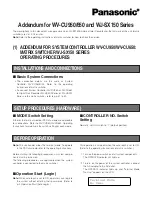
Command Modes
CONFIGURATION-EXTENDED-ACCESS-LIST
Command History
This guide is platform-specific. For command information about other platforms, see the relevant
Dell Networking
OS Command Line Reference Guide
.
Version
Description
9.10(0.0)
Introduced on the S6100.
9.8(1.0)
Introduced on the Z9100–ON.
9.8(0.0P5)
Introduced on the S4048-ON.
9.8(0.0P2)
Introduced on the S3048-ON.
9.7(0.0)
Introduced on the S6000–ON.
9.4(0.0)
Added support for flow-based monitoring on the S4810, S4820T, S6000, and Z9000
platforms.
9.3.0.0
Added support for logging of ACLs on the S4810, S4820T, and Z9000 platforms.
Usage Information
When the configured maximum threshold is exceeded, generation of logs is stopped. When the interval at which
ACL logs are configured to be recorded expires, the subsequent, fresh interval timer is started and the packet
count for that new interval commences from zero. If ACL logging was stopped previously because the configured
threshold is exceeded, it is re-enabled for this new interval.
If ACL logging is stopped because the configured threshold is exceeded, it is re-enabled after the logging interval
period elapses. ACL logging is supported for standard and extended IPv4 ACLs, IPv6 ACLs, and MAC ACLs. You
can configure ACL logging only on ACLs that are applied to ingress interfaces; you cannot enable logging for ACLs
that are associated with egress interfaces.
You can activate flow-based monitoring for a monitoring session by entering the
flow-based enable
command in the Monitor Session mode. When you enable this capability, traffic with particular flows that are
traversing through the ingress and egress interfaces are examined and, appropriate ACLs can be applied in both
the ingress and egress direction. Flow-based monitoring conserves bandwidth by monitoring only specified traffic
instead all traffic on the interface. This feature is particularly useful when looking for malicious traffic. It is available
for Layer 2 and Layer 3 ingress and egress traffic. You may specify traffic using standard or extended access-lists.
This mechanism copies all incoming or outgoing packets on one port and forwards (mirrors) them to another port.
The source port is the monitored port (MD) and the destination port is the monitoring port (MG).
Related Commands
•
— create an extended ACL.
•
— assign a permit filter for IP packets.
•
— assign a permit filter for TCP packets.
permit (for Extended IP ACLs)
To pass IP packets meeting the filter criteria, configure a filter.
Syntax
permit {
source mask
| any | host
ip-address
} {
destination mask
| any | host
ip-
address
} [count [bytes]] [dscp
value
] [order] [fragments] [log [interval
minutes
] [threshold-in-msgs [
count
]] [monitor]
To remove this filter, you have two choices:
•
Use the
no seq
sequence-number
command if you know the filter’s sequence number.
Access Control Lists (ACL)
303
Содержание S6100
Страница 1: ...Dell Command Line Reference Guide for the S6100 ON System 9 11 2 0P1 ...
Страница 474: ...protocol list ttl0 ttl1 Dell 474 Control Plane Policing CoPP ...
Страница 979: ... show lldp neighbors display the LLDP neighbors Link Layer Discovery Protocol LLDP 979 ...
Страница 1627: ... uplink state group creates an uplink state group and enables the tracking of upstream links Uplink Failure Detection UFD 1627 ...
















































